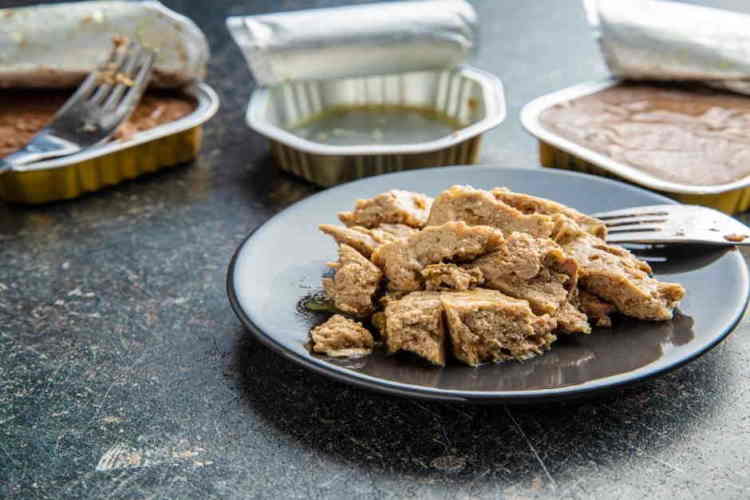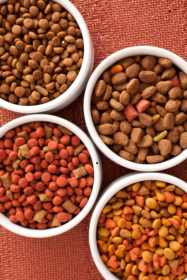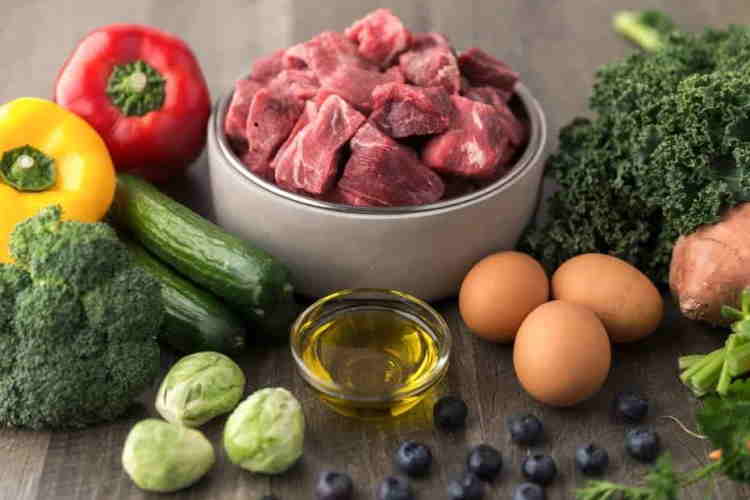Dog Food Ingredients Explained: Which Ingredients Are Good For Your Dog and Which To Avoid
BY MOLLY | EVERYTHINGSHIHTZU.COM
Have you ever read a list of dog food ingredients and often wondered what it all meant and if it's the best dog food for your dog?
Many of us want our Shih Tzu or any of our pets to be healthy and eat quality meals, but we aren't quite sure how to read the labels on the back of the containers.
 What's in your dogs food?
What's in your dogs food?In general, dog foods sold at the grocery store are of lower quality ingredients than foods sold at a pet specialty store or online pet retailers.
However, buying dog food from the grocery store is often more convenient for many people and usually less expensive than higher-quality pet foods.
So what’s a dog guardian to do?
How to choose the right dog food?
The number one thing you should look for when buying foods for your pet, no matter where you buy them from, is the AAFCO approval statement.
It will read something like this...

"XYZ product is formulated to meet the nutritional levels established by the AAFCO Dog Food nutrient profiles for growth and maintenance."
AAFCO provides minimum standards for dog food ingredients and their manufacturers, so you know that foods carrying this statement are a complete diet.
But remember that these are minimum standards, so just because the container has the AAFCO statement on its label does not mean that it has high-quality ingredients; however, it is typically better than one that doesn't have it on the label.
There are also some ingredients that you should search for, while others you should avoid if possible.
How to Read Dog Food Ingredients on Labels

Ingredients must be listed in order from the largest to the least, which means that the first ones listed weigh more than the last ones listed.
If the first ingredient is corn, you know that there is more corn in the food than anything else.
Dog food experts frequently say good food selections should have a couple of meats listed in the top five ingredients.
It should preferably be listed first, showing that it’s the largest ingredient by weight before processing.
Your dog can digest meat protein from chicken, lamb, turkey, fish, beef, and venison more easily than protein from corn or other grain sources.
- Meat Proteins & By-Products
Meat is the clean flesh of the chicken, turkey, lamb, etc. It includes the tongue, heart, esophagus.
The term “by-products” is the clean parts of animals other than meat. These include lungs, spleen, kidneys, brain, livers, blood, bone, stomach, and intestines.
Doesn’t that sound yummy? Well, to a dog, it doesn’t sound all that bad.
Sometimes you'll see the by-products defined by the name of the species, for example, beef by-products or chicken by-products.
Although not as wholesome as just beef or chicken, it is more acceptable than a non-defined animal by-product usually listed as "meat by-product," "poultry by-product," or "animal by-product."
So if you decide to go with dog food containing by-products, the better choice is to pick one that specifies from which animal it came.
If you can avoid a by-product entirely and go with dog food which lists, for instance, beef, carrots, rice as its ingredients, this would be a much better choice.
- Real vegetables, whole grains, and real fruit
Dogs can derive health benefits from certain unprocessed vegetables and fruits in their foods, such as sweet potato, carrots, and blueberries.
Some unprocessed fruits and vegetables have antioxidant properties which are suitable for your dogs' health.
They should never be the main ingredient, but small amounts are beneficial to your dogs' diet and provide some nutrition.
- Oils and healthy fats
Every dog needs a bit of oil and fats in its daily diet. Look for foods that use chicken fat, flaxseed oil, canola oil, and any food with Omega-3 and Omega-6 fatty acids.
Many lesser quality foods contain generic animal fats, and you don’t know what the ingredients are; it could be any animal. Instead, look for named sources of fat.
- Artificial Preservatives
Avoid artificial or chemical preservatives like Ethoxyquin, BHA, and BHT.
Look for foods with natural preservatives like Vitamin C and Vitamin E instead, also known as Tocopherols.
Ethoxyquin has been suspected of causing liver damage and other health problems in dogs.
- Corn
Corn is a popular food ingredient in most grocery store brands of dog food, and you can even find it in some premium foods.
It’s often used because it is a less expensive source of protein than meat protein.
But it’s not the most nutritious ingredient, and it should never be the first ingredient in your dog food.
Dogs are not vegetarians and don’t digest vegetable matter particularly well. In fact, a dog only digests about 50 percent of the corn they eat.
This means the rest of the corn (corn meal, ground yellow corn, whole corn, etc.) passes through his gastrointestinal tract and doesn’t get the nutrients from it. The rest you pick up as waste in your yard or when you walk him.
- Added Flavor
Flavorings are often added to food to make it taste better or more appealing to a dog, but they are not a necessary part of the dog food.
Read the food labels to find out what types of flavorings are added.
The best type is a specific broth or stock. Try to avoid unspecified flavorings or artificial ones.
- Artificial colors and sweeteners
It's best to avoid artificial colors and sweeteners if you can. Your dog just doesn’t need these in their diet and has no nutritional benefit.

Before discovering the importance of quality dog food ingredients, I fed our Shih Tzu dog food without giving it much thought; as long as they ate it, they would be fine.
On a routine visit to the vet, she asked what we were feeding them. She gently suggested that they may do better with a higher quality dog food.
I’ve been reading labels ever since.
It took a little trial and error, but I found the best dog food I could that they will actually eat because let’s face it, what good is having high-quality ingredients if they won’t eat it.
With all the information about dog food ingredients these days, it can seem a little overwhelming.
However, we should learn what we can about keeping our furry friends healthy and fit by knowing what we are feeding them.
In the book Big Kibble: The Hidden Dangers of the Pet Food Industry and How to Do Better by Our Dogs, you may be horrified to learn some dangers of some commercial dog foods and how making better choices in what you feed your dog will keep them in better health.
It will really open your eyes to how important it is to know what you are feeding your beloved pets and how you can keep your precious little fur-babies happy and healthier.
- Home
- Shih Tzu diet
- dog food ingredients
Posted 3/11/2021




